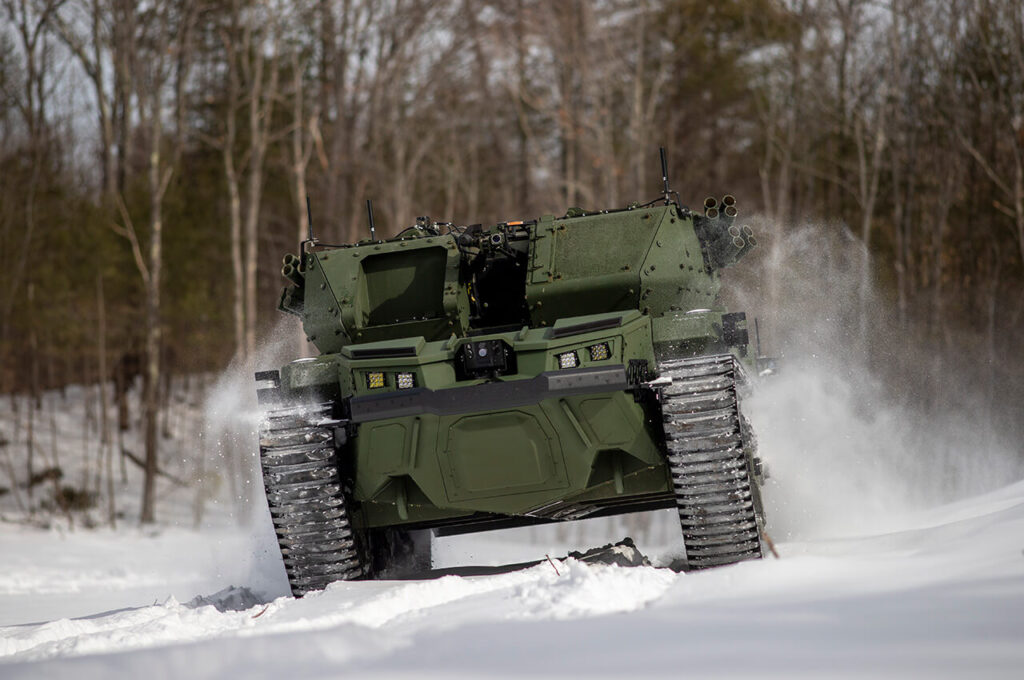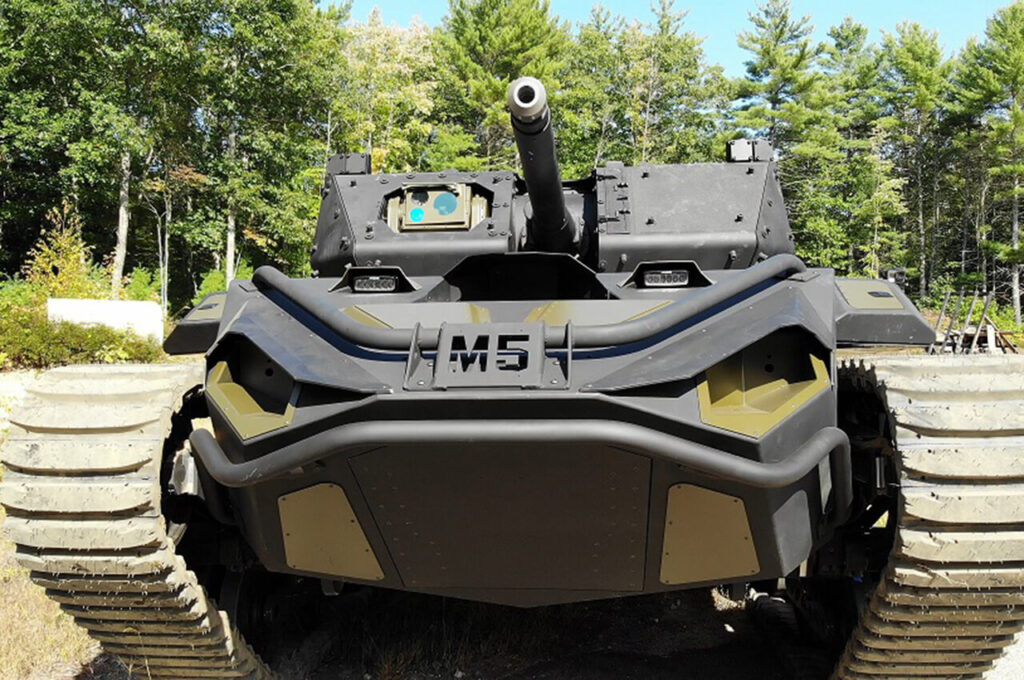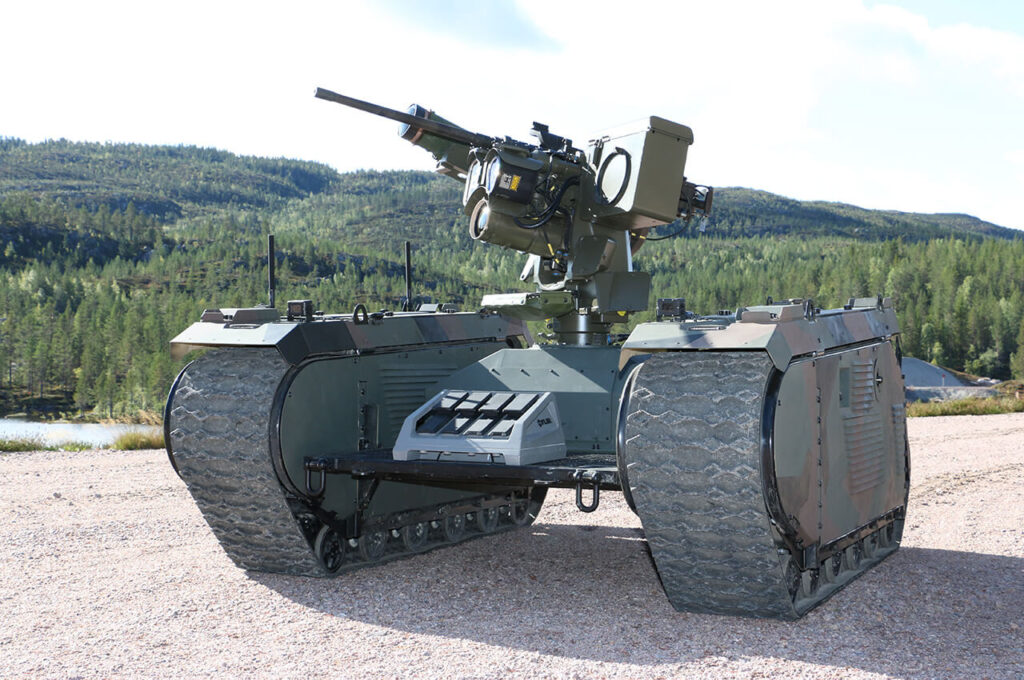INTRODUCTION
Militaries worldwide are actively evaluating the benefits of Autonomous/ Robotic Combat Vehicles (RCVs). Within the next 5 – 10 years, RCV’s could be at a Military Commanders disposal, and play an active part on the battlefield of the near future. Understanding how RCV’s will be introduced, used doctrinally, and under what legal limitations, can only be understood if early engagement is made with industry.
The questions of ‘can we’ is rapidly being replaced with ‘should we’. Distancing the soldier from harm is a worthwhile pursuit, as long as it is controllable and doesn’t add to the burden of the current force.


Logistically, the advantages of Soucy’s Composite Rubber Track (CRT) is well known on manned vehicles, and the crossover to RCV’s is even more important. An unmanned system does not have the manpower for maintenance, and therefore any move to lessen the logistic burden means increases the time on task for the RCV. There are many reasons why CRT is an asset to RCV:
| MAINTENANCE | CRT has low maintenance requirements which enable Commanders to better forecast maintenance breaks into their mission analysis. With the average weight of an RCV being much lighter than current armored vehicles, the CRT durability is increased therefore in most circumstances, can operate unmaintained for up to 8000 Kms. The collaboration of wheeled and tracked vehicles is becoming more important as future conflicts are almost certainly going to be more enduring operations. The Mean Time Between Failure (MTBF) on conventional Steel Track (ST) is much less than that of CRT which prevents combined arms working together at reach. The introduction of CRT would allow formations to maintain battle rhythm. The additional hardware that accompanies the CRT such as sprockets, road wheels and support rollers are also designed to complement the durability of the CRT, in addition the maintenance free characteristics of CRT ensures autonomous systems stay ‘on task’ and are not operationally effected by wear and tear essential maintenance procedures therefore there is no requirement for scheduling maintenance breaks into the Commanders estimate. |
| 5 PRIORITIES OF RCV | Sustainability – The ability of being able to continue over a longer period of time than conventional ST. CRT has less ground pressure and therefore causes less damage to existing road networks. This applies more so during peacetime training exercises as local authorities want assurances from senior military commanders that no lasting damage will be be caused to the local infrastructure or environment that can potentially have a cost of repair. Maneuverability – CRT traction has been proven on manned vehicles allowing platforms to utilize previously ‘no go’ terrain. If you want less ground pressure, you have to choose tracks. Tracks have significantly lower ground pressure than wheels and are more suited to soft surfaces. Large tires could be used in soft surfaces however would be limited to the types of terrain they operated – for example on snow. This is also the case where RCV may be used in the sea to land amphibious role as CRT is saltwater resistant, has reduced corrosion and aids in platform buoyancy Situational Awareness (SA) – SA is key in the battle winning sphere. To effective combat decision making in the tactical environment a commander must have up to the minute cognizance or the awareness required to operate equipment at reach. With CRT’s no maintenance attributes, platforms have greater battlefield range giving leaders this ability, in turn may giving a tactical advantage. Lethality – In recent conflicts in Iraq and Afghanistan combat vehicles have increased in weight because of new and increasing threats. Militaries are looking to find the balance between increasing the lethality aspects of their armored platforms whilst reducing the weight to be more rapidly deployable. On average CRT weighs 50% less than conventional ST, this weight saving can be used by designers to enhance lethality components of their platforms. Survivability – Predominantly RCV will be used to replace humans in hazardous situations, such as handling explosives, bomb disabling vehicles and where humans cannot easily go. The integration of CRT with its smooth-running profile prevents ‘track slap’ being transmitted to on board explosives and ammunition prolonging their effectiveness. |
| ON BOARD ELECTRONIC SENSORS | RCV inevitably have a plethora of electronic sensors fitted to enable them to perform to their optimum potential. With a 70% reduction in vibration felt on armored platforms fitted with CRT, the durability of the on-board electronics is enhanced enabling them to remain combat effective longer. The unique design of CRT promotes less vehicle ground pressure which induces a reduced dust cloud emanated from platforms. This will prolong the life of the electronic circuits boards and sensors fitted to RCV. |
| POTENTIAL RCV USES AND CRT ADVANTAGES | Hazardous Situations – Predominantly RCV are used to replace humans in hazardous situations, such as handling explosives, bomb disabling vehicles and where humans cannot easily go. The integration of CRT with its smooth-running profile prevents ‘track slap’ being transmitted to on board explosives and ammunition prolonging their effectiveness. Reconnaissance – Due to the rubber on rubber design of CRT there is an overwhelming noise reduction during operation. With RCV potentially being used in the reconnaissance, surveillance and target acquisition fields the decrease in emitted noise is a big advantage. The proven acceleration enhancement of vehicles fitted with CRT would give RCV the edge in combat reconnaissance. Amphibious – Nations are conducting R&D into amphibious RCV that will give them the ability to conduct logistical missions from sea to land. CRT has many attributes that would enhance the performance of a land/amphibious platform such as, saltwater resistance, buoyancy and reduced corrosion. |
| WEIGHT | RCV may require the ability to be para dropped onto the battlefield hence they are lighter in design. The addition of CRT being on average 50% lighter than conventional ST would give potential OEMs scope to develop the lethality aspects of the platform. |
CONCLUSION
In order to preserve life, enhance capabilities and gain a tactical edge over near peer groups, Militaries are increasing their R&D into the potential integration of RCV. It’s therefore inevitable that Nations will demand the most compatible products for their designs. With its proven record on manned vehicles the Soucy CRT with all the attributes it brings should be the ‘track of choice’for RCV. Due to the durability that is provided by CRT the Life Cycle Costs (LCC) for any given platform would be significantly reduced allowing more resource to be focused on critical battle winning assets.
